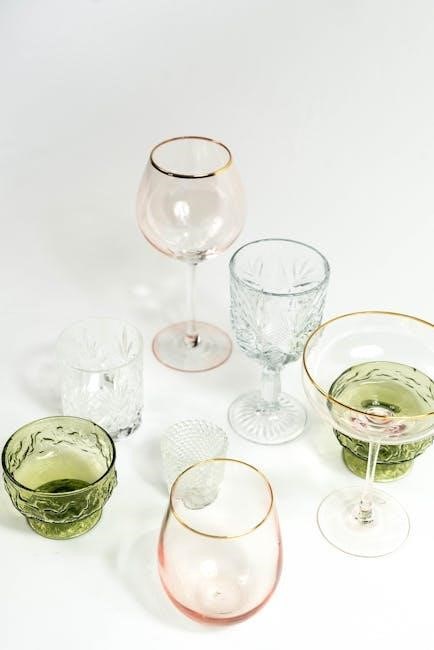Choosing the right glasses size is crucial for comfort, functionality, and style. This guide helps determine the perfect fit by understanding key measurements and face shape analysis.
1.1 Importance of Proper Fit in Eyewear
A proper fit in eyewear ensures comfort, vision clarity, and frame stability. Ill-fitting glasses can cause discomfort, slipping, or distorted vision. Correct sizing prevents pressure points, while frames that are too loose may slip, affecting optical accuracy. Proper fit enhances both functionality and aesthetics, making it essential for everyday wear. Measuring key dimensions like lens width, bridge width, and temple length helps achieve a precise fit. Frames that align with face shape and size promote long-lasting comfort and style, ensuring eyewear meets both practical and cosmetic needs effectively.
1.2 Overview of Key Measurements
Key measurements for glasses include lens width, bridge width, temple length, and frame height. Lens width is the horizontal measurement of each lens at its widest point. Bridge width refers to the distance between the two lenses. Temple length measures the arms extending from the lenses to the ears, ensuring stability. Frame height determines how the eyewear sits on the face. These measurements are typically displayed in millimeters and vary by frame size categories. Accurate measurements ensure a comfortable and secure fit, essential for both functionality and style. Proper sizing enhances the overall wearing experience.
Key Measurements for Glasses Frames
Key measurements for glasses frames include lens width, bridge width, temple length, and frame height, ensuring proper fit and comfort for different face shapes and activities.
2.1 Lens Width: Definition and Importance
Lens width is the horizontal measurement of each lens at its widest point, typically ranging from 40 to 60 millimeters. It is the most critical measurement for ensuring optimal vision clarity and comfort. Proper lens width aligns with the user’s pupil distance, preventing blurred vision or eye strain. Measuring lens width accurately ensures the frames fit well without slipping or causing discomfort. This measurement is essential for both functional and aesthetic reasons, as it directly impacts how the glasses sit on the face and how they perform their intended purpose.
2.2 Bridge Width: Measurement and Significance
Bridge width measures the distance between the two lenses, spanning the nasal area. It ensures proper fit and comfort, typically ranging from 14 to 24 millimeters. A well-fitted bridge prevents slipping and distributes the frame’s weight evenly. Incorrect bridge width can cause discomfort or improper lens alignment. This measurement is vital for ensuring the glasses stay in place and maintain optical accuracy. Bridge width varies by frame style and face shape, making it a key factor in selecting frames that provide both functionality and aesthetic appeal.
2.3 Temple Length: Role in Frame Stability
Temple length refers to the measurement of the arms that wrap around the ears, ensuring stability and comfort. Proper temple length prevents slipping and distributes weight evenly. Typically ranging from 130 to 150 millimeters, it varies by frame design and user preference. Correct temple length ensures the frames stay securely in place, enhancing both functionality and comfort. This measurement is crucial for long-term wearability and prevents discomfort or constant adjustments. It is essential to consider temple length when selecting frames to ensure optimal fit and stability.
2.4 Frame Height: Determining the Right Proportions
Frame height is the vertical measurement of the eyewear, influencing both style and functionality. Proper proportions ensure the frames complement facial features without overwhelming them. Typically measured from the top of the frame to the bottom, height varies based on design and face shape. For instance, taller frames suit longer faces, while shorter frames balance rounder faces. Correct proportions enhance comfort and aesthetics, ensuring the eyewear sits naturally without slipping or causing discomfort. Measuring frame height accurately helps in selecting frames that align with individual preferences and facial harmony.

Understanding Face Shape and Frame Size
Understanding your face shape is essential for selecting frames that flatter your features. Oval, square, round, and heart-shaped faces each require specific frame styles for optimal fit and aesthetics.
3.1 Common Face Shapes and Their Characteristics
There are four primary face shapes: oval, square, round, and heart-shaped. Oval faces are symmetrical with balanced proportions. Square faces have strong jawlines and angular features. Round faces are curved with full cheeks, while heart-shaped faces feature a broader forehead and temples with a narrower chin. Each shape has unique characteristics that influence frame selection. Understanding your face shape is the first step in finding glasses that complement your features and enhance your appearance. This knowledge helps in narrowing down frame styles that will flatter your face naturally.
3.2 Matching Frame Sizes to Face Shapes

Matching frame sizes to face shapes ensures a flattering and comfortable fit. Oval faces suit frames as wide as or slightly wider than their broadest point. Square faces benefit from softer, rounded frames to balance angular features. Round faces look best with angular or rectangular frames to add definition. Heart-shaped faces are complemented by frames that are wider at the bottom to draw attention downward. Properly sized frames enhance both aesthetics and comfort, making it essential to align frame dimensions with individual facial contours for a personalized look. This tailored approach ensures glasses complement your unique features seamlessly.

How to Measure Your Glasses Size
Use a ruler to measure lens width, bridge, and temple length for accurate sizing. Refer to frame size guides for precise measurements and a perfect fit.
4.1 Using a Ruler for Accurate Measurements
To ensure a precise fit, use a ruler to measure key frame dimensions. Start by measuring the lens width at its widest point, typically around 50-60 mm. Next, measure the bridge width, which usually ranges from 14-24 mm. Finally, measure the temple length, which is generally between 135-150 mm. Hold the ruler flat against the frame and take note of each measurement. For accuracy, measure both lenses and compare. Use a mirror to align the ruler correctly. These measurements will help you determine your ideal frame size and ensure a comfortable, well-fitting pair of glasses.
4.2 Interpreting Frame Size Numbers
Frame size numbers are typically displayed in millimeters and consist of three key measurements: lens width, bridge width, and temple length. For example, a frame labeled 53-18-138 means the lens is 53 mm wide, the bridge is 18 mm, and the temples are 138 mm long. These numbers are essential for selecting frames that fit your face perfectly. Most frames fall into small, medium, or large categories, with sizes ranging from less than 125 mm to over 136 mm in internal width. Understanding these numbers ensures you choose a frame that matches your facial dimensions for optimal comfort and style.
Frame Size Categories
Glasses frames are categorized into small, medium, large, and extra-large sizes, catering to various face dimensions and personal preferences for a tailored fit.
5.1 Small, Medium, and Large Frames: What’s the Difference?
Glasses frames are categorized into small, medium, and large sizes based on internal frame width. Small frames are ideal for narrower faces, measuring less than 125mm. Medium frames, measuring 126-130mm, suit average face sizes, while large frames (131-135mm) accommodate broader facial features. Extra-large frames exceed 136mm, catering to larger head sizes. These categories help in selecting frames that fit comfortably and proportionally, ensuring optimal vision and style. Proper sizing enhances both functionality and aesthetic appeal, making it essential to choose the right category for your face shape and preferences.
5.2 Extra-Large and Specialty Sizes
Extra-large and specialty frames cater to unique needs, offering sizes beyond standard measurements. Extra-large frames exceed 136mm in internal width, providing a comfortable fit for larger head sizes. Specialty sizes are tailored for specific requirements, such as oversized styles or frames designed for particular activities like sports. These options ensure that individuals with distinct preferences or larger facial structures can find glasses that fit perfectly. Whether for fashion or functionality, extra-large and specialty sizes offer versatility, ensuring everyone can enjoy optimal comfort and style in their eyewear.
Sizing Variations for Different Activities
Glasses sizing varies for activities like sports, where stability is key, and fashion, where style often dictates frame size choices, ensuring optimal performance and aesthetic appeal.
6.1 Sport and Running Sunglasses: Unique Sizing Needs
Sport and running sunglasses require a snug, secure fit to stay in place during active movements. Frame sizes often prioritize stability over style, with wider temple lengths and rubber grips for added comfort. Lens width and bridge width are critical to ensure optimal coverage and reduced glare. Wraparound styles are common, offering better protection. Measurements like temple length and frame height are tailored to Prevent slipping, even during intense activities. Proper sizing ensures clear vision and comfort, making sport-specific frames a necessity for athletes and runners seeking both functionality and performance.
6.2 Fashion Frames: Size vs. Style Considerations
Fashion frames often prioritize style over traditional sizing, offering unique shapes and bold designs. While size is still important for comfort, fashion frames may feature oversized lenses or slim profiles to match current trends. Materials like acetate and metal allow for vibrant colors and intricate details, enhancing the aesthetic appeal. However, ensuring a proper fit is crucial to maintain both functionality and style. Frames may come in various sizes, but the key is balancing proportions with personal face shape. Fashion eyewear encourages self-expression while still requiring careful measurement to ensure comfort and clarity.

Materials and Frame Size
Materials like wood, metal, and acetate influence frame size and durability. Each material offers unique size options, from slim metal profiles to versatile acetate shapes.
7.1 Wooden Frames: Size and Durability
Wooden frames offer a unique combination of style and durability. Their size can vary, with some designs featuring bulkier constructions for a statement look. When choosing wooden frames, consider the type of wood, as it impacts both appearance and durability. Proper sizing ensures comfort and stability, especially for larger or heavier wooden frames. Measuring the frame’s width and temple length is crucial for a secure fit. Durable woods like bamboo or ebony are popular choices, blending natural aesthetics with long-lasting wear. Ensure the frame’s construction aligns with your face shape for optimal comfort and style.
7.2 Metal Frames: Slim Profiles and Size Options
Metal frames are known for their slim profiles and versatility in sizing. They offer a range of size options, from delicate, minimalist designs to slightly larger, statement pieces. The key measurements—lens width, bridge width, and temple length—are crucial for ensuring a comfortable fit. Metal frames are durable and retain their shape well, making them a practical choice. Slim profiles suit smaller face shapes, while larger sizes can complement broader features. With various materials like stainless steel or titanium, metal frames provide both strength and style, catering to diverse preferences and needs.
7.3 Acetate Frames: Versatility in Size and Shape
Acetate frames are celebrated for their versatility in size and shape, offering a wide range of styling options. Made from high-quality cellulose acetate, these frames are durable yet lightweight, making them suitable for various face shapes. Their moldable nature allows for intricate designs and a broad spectrum of colors. Acetate frames are available in small, medium, and large sizes, ensuring a personalized fit. They are ideal for those seeking a balance between style and comfort, as they can be tailored to individual preferences while maintaining structural integrity and aesthetic appeal.
8.1 Final Tips for Choosing the Perfect Frame Size
When selecting glasses, ensure the frame aligns with your face shape and personal style. Measure lens width, bridge width, and temple length accurately for a precise fit. Consider the material, as options like acetate, metal, or wood offer unique benefits. If unsure, refer to size guides or consult professionals. Comfort and functionality are key, so prioritize frames that complement your features while meeting your lifestyle needs. A well-fitting pair enhances both vision and confidence, making it worth the effort to find the ideal match.
